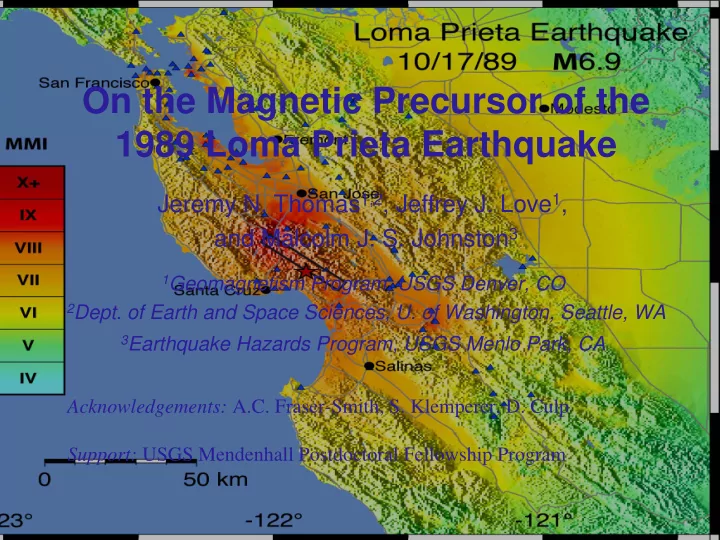

On the Magnetic Precursor of the 1989 Loma Prieta Earthquake Jeremy N. Thomas 1,2 , Jeffrey J. Love 1 , and Malcolm J. S. Johnston 3 1 Geomagnetism Program, USGS Denver, CO 2 Dept. of Earth and Space Sciences, U. of Washington, Seattle, WA 3 Earthquake Hazards Program, USGS Menlo Park, CA Acknowledgements: A.C. Fraser-Smith, S. Klemperer, D. Culp Support: USGS Mendenhall Postdoctoral Fellowship Program
The 1989 Loma Prieta Earthquake • Occurred at 00:04 UT Oct. 18, 1989 • Epicenter 37.04 ° N, 121.88 ° Corralitos W in Santa Cruz Mtns. • M s 7.1 FRN � • Depth of 18 km • Widespread damage in San Francisco Bay Area
E-W Magnetic Field Data Corralitos, CA (ULF, 0.01 – 10 Hz) • 42.70 N (mag); 7 km from epicenter • 30-minute spectral-power averages determined in 9 frequency bands using data from E-W magnetic-induction coil sensor. • Increased noise in MA3 index reported as a precursor by Fraser- Smith et al., GRL, 1990. Longer term data, log books plus other overlapping data now available at FRN and Kakioka (KAK), Japan -Kakioka, Japan (KAK) 1Hz data • 28.90 N (mag); 8,284 km from epicenter • 30-min average power in same frequency bands as Corralitos -USGS Fresno, CA (FRN) 1-minute data • 43.20 N (mag); 201 km from epicenter • 30-min average power in band-pass just below the frequencies of the first Corralitos index but the same bandwidth
COR Sept. and Oct. 1989 LP
CORR – All Indices (21 Months)
Correlation and Significance
Sept. – Oct. 1989 Data
Search for gain and timing correction at COR using correlation analysis • Suggests gain reduction 12.05 for COR-KAK and 13.45 for COR- FRN (Oct 5-17). Therefore, use average gain factor of 12.75 • Suggests time correction of 3.00 min. COR-KAK and 3.55 for COR-FRN (Oct 5-17). Therefore, use average time-correction of 3.30 min
COR gain adjusted by 12.75
COR time correction by 3.3 min Oct .5-18
Other odd behavior observed – (1) Apparent frequency shifting 12 Sep. – 5 Oct. 1989
Apparent frequency shifting 12 Sep. – 5 Oct 1989
Other odd behavior observed (2) Corralitos data from Oct 5-17 is missing diurnal variation • Peaks at 1-cycle and 2- cycles per day until October 4 • Holes at 1-cycle and 2- cycles per day from October 6-17. • It appears that these data might have been inadvertently filtered since no known physical mechanism could cause this behavior.
Our Findings 1 • Several distinctly non- geophysical behaviors are observed in the E-W magnetic field data from Corralitos. • Most disturbing are noise-level baseline shifts that occurred before and long after the earthquake and at other times. • The 6 October to July, 1990 baseline shifts with peaks in Oct/Nov and June, 1990 continued until an amplifier was finally replaced on 10 July 1990. • None of these noise-level shifts were accompanied by significant changes in the calibration (CAL) index.
Our Findings 2 • COR, KAK, and FRN correlated well up to Oct 6, 1990 and again began to correlate well after 10 July 1990 amplifier replacement. • Likely amplifier malfunction during this period is indicated by 1) correlation analysis and 2) response differences between CORR and KAK or FRN to geomagnetic disturbances.
Conclusions Conclusions A faulty amplifier appears to be the most likely reason for the noise � A faulty amplifier appears to be the most likely reason for the noise � power level fluctuations observed to start one week preceding the M7 power level fluctuations observed to start one week preceding the M7 Loma Prieta earthquake and to continue long after the event. This would Loma Prieta earthquake and to continue long after the event. This would explain apparent gain increases in the Corralitos data after Oct. 5, 1989 explain apparent gain increases in the Corralitos data after Oct. 5, 1989 to July, 199, indicated by 1) variation in cross correlation of CORR with to July, 199, indicated by 1) variation in cross correlation of CORR with KAK and FRN and 2) comparison of relative amplitudes of KAK and FRN and 2) comparison of relative amplitudes of electromagnetic disturbances. electromagnetic disturbances. Other non-geophysical behaviors are also evident in this single data set Other non-geophysical behaviors are also evident in this single data set � � and are unexplained at this point. and are unexplained at this point. Key aspects of the anomalous magnetic variations observed at Corralitos � Key aspects of the anomalous magnetic variations observed at Corralitos � and claimed as a precursor appear therefore not to be related to the Loma and claimed as a precursor appear therefore not to be related to the Loma Prieta earthquake but are artifacts of a sensor-system malfunction. Prieta earthquake but are artifacts of a sensor-system malfunction. Moral - Measurements with multiple instrument in arrays are clearly � Moral - Measurements with multiple instrument in arrays are clearly � necessary for determining the reality, or lack thereof, of geophysical necessary for determining the reality, or lack thereof, of geophysical signals, and for isolating problems of instrumental origin. signals, and for isolating problems of instrumental origin.
Recommend
More recommend